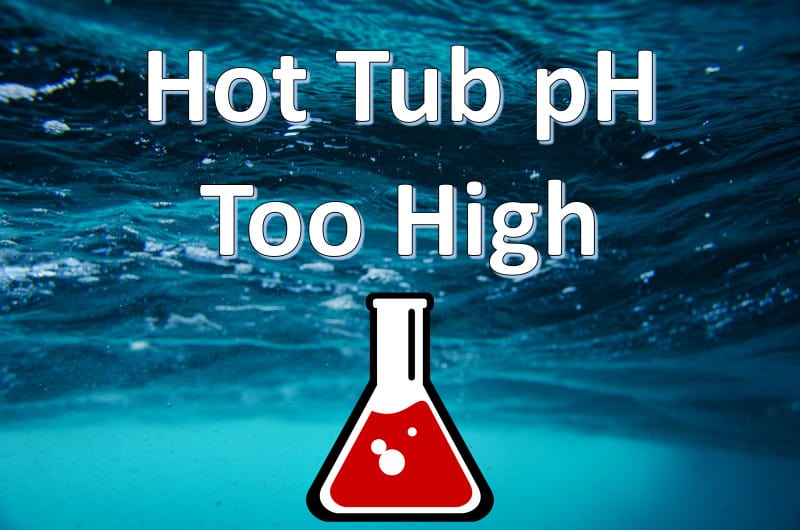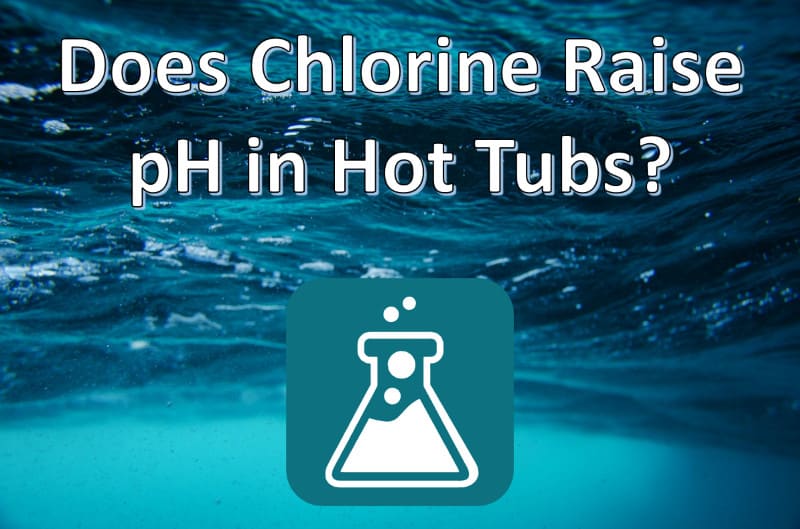Why is my hot tub water pH too high?
You’ll find your hot tub pH too high because of high alkalinity. You should maintain your hot tub’s pH within the required levels by adding appropriate compounds like sodium bisulfate to lower the pH and keep it within the range of 7.2 – 7.8.
Stop wasting time and money with hot tub maintenance and confusing water chemistry! The Hot Tub Handbook and Video Course will help keep your hot tub balanced, sanitized, and crystal clear all the time.
Check out my list of high-quality hot tub products to help keep your hot tub clean and running great all year long!
My recommended product to help you test your hot tub or pool water for accurate pH, alkalinity, bromine, and chlorine readings is the AquaCheck Trutest Digital Reader.
Your hot tub’s pH is critical because it determines the state of chemical balance in the water. I have noticed that acidity is a common problem for hot tub owners than high pH levels. When the latter occurs, the hot tub water starts to form scale.
I encourage keeping the pH level within the required levels because high pH is damaging to the hot tub and can lead to increased sanitizer use. It can also cause premature equipment failure.
Let’s get started!
Ideal pH Range For Hot Tubs: 7.2 – 7. 8
The ideal pH range for your hot tub should always be in the range of 7.2 – 7.8. I recommend testing the pH regularly, usually twice a week with test strips or a test kit to ensure that it is within the desirable range. You may also establish the accuracy of your test results by taking a sample of your hot tub water to your local dealer for testing.
If you own a hot tub, always remember that keeping the water in the proper chemical balance is the biggest and essential part of its care. Keeping the correct chemical balance in your hot tub provides benefits such as cleanliness and safety of your hot tub. Besides, it will help create appropriate conditions for other chemicals in your hot tub to function properly.
For example, Chlorine will not be effective at high pH levels. Experts report that Chlorine is only 15% effective at a pH of 8.2. For this and other reasons, I advise hot tub owners to keep the water within the range of 7.2 – 7.8 if they wish to get the best results in terms of chemical efficiency and hot tub functionality.
Consider Using a Water Care Monitor
Monitoring the health of your hot tub can often be challenging if you are not testing the water on a regular basis. This can also be a problem if you go on holiday or you are unable to take care of your hot tub due to mobility issues.
A test system I highly recommend is the Exact Industrial Test System. This system is great for hot tubs and pools and gives your a highly accurate digital readout of your water chemistry compared to other methods.
The pHin Smart Water Care Monitor for pools, hot tubs, and inflatable spas continuously tests the water and alerts you when to add chemicals with the integrated mobile app.
This water care monitor also takes constant readings of the temperature inside your hot tub. This will give you peace of mind while away from your spa.
The mobile app will inform you when to add chemicals such as chlorine, and how much chemical is recommended. This is done by entering your hot tub or pool’s unique dimensions.
Simply scan the bar code of any chemical brand and the pHin app will calculate how much chemical is to be added to the water. Most products and brands are recognized by the application.
The pHin device will sample water more than 1000 times per week to give you an accurate reading compared to using test strips.
The pHin device works with different water types including chlorine, bromine, and saltwater hot tubs, swim spas, inflatable hot tubs, and pools.
This unique device comes with a lifetime warranty to ensure your water remains clear and ready for you to use at all times.

Stop wasting time and money with hot tub maintenance and confusing water chemistry! Get Instant access to this easy-to-use book and video course so you can spend less time cleaning and more time soaking.
Learn MoreHow Do I Lower The pH In My Hot Tub?
Ideally, you need to add an appropriate compound that will lower your hot tub’s pH. An acidic compound has low pH, meaning it will be highly suitable in scaling down the alkalinity levels. A common compound I found effective is sodium bisulfate, which is usually a dry form of an acid. You need to add sodium bisulfate in recommended amounts daily until the pH falls to the necessary levels.
However, you can also find liquid forms of acidic compounds recommended for hot tubs at your local dealer. I discourage adding high acidic compounds or targeting to lower the pH at once. The liquid forms of the compounds are more aggressive in lowering the pH. Your local dealer will always guide you on the doses you need to add to the hot tub daily. Add the recommended doses while testing until you get to the point where the pH is at the right balance.
Some people mistake that baking soda helps in lowering the pH of the hot tub water. However, high pH is related to alkalinity, but the control method for each is different. That is why compounds like baking soda work to increase the alkalinity of your hot tub water and not its pH.
However, I found that pH is highest when the alkalinity levels are high. Indeed, high alkalinity indicates that the pH is high. You could lower your hot tub’s alkalinity before working on the pH because it will be faster to restore it to the appropriate pH levels.
Your aim should be to keep the hot tub water within the correct state of chemical balance, which requires you to add the right pH reducer to lower the pH levels.
I recommend Hot Tub Things pH and Alkalinity Down to help lower the pH in your hot tub.
What Happens If Hot Tub pH Is Too High?
High pH is not suitable for your hot tub. If it is too high, it will start to form scales. High pH levels in your hot tub contribute to the formation of chalky deposits on the hot tub’s surface, especially if there are high temperatures and significant amounts of calcium. The chalky deposits feel like sand on the surfaces of acrylic hot tubs. Besides, you might notice white flakes from the jets, which could get caught in the filters and plugin. The effective circulation of the hot tub water will be hindered, leading to flow error problems.
The effect of high pH levels in a hot tub could extend to the heater surfaces and the plumbing, where scales could start to form. The effects of scaling on the two components could affect the normal functioning of the hot tub. Specifically, the blockage could happen in the plumbing, affecting the water circulation. It could also strip the breaker and cause heater failure.
It’s important to remember that the scaling effect of the plumbing system increases the water pressure in the circulation system, straining the hot tub equipment. Specifically, it can cause damage to the pump or accelerated wear and tear because of forcing it to do extra work to circulate the water.
Is It Safe To Get In A Hot Tub With High pH?
It is not safe to get into a hot tub with high pH. A pH value of 7.8 or higher is considered to be a high pH when measured with a pH strip. Water at these levels is too alkaline that it reduces the effectiveness of Chlorine, the chemical compound responsible for killing pathogens in your hot tub water. Therefore, getting into this water will put you at risk of contracting pathogenic infections. Specifically, water is contaminated with pathogens that can cause waterborne diseases, as well as skin and eye infections.
I have found common complaints from people who soak in hot tub water with too high pH levels, including itchiness in their skin or burning sensation in their eyes. You don’t want to experience the same irritation by soaking in your hot tub when the water pH test is too high. For this reason, make sure that you maintain the pH within the recommended limits.
Can High pH In A Hot Tub Cause A Rash?
Yes, at high pH levels, your hot tub water becomes scale forming. The rate of sanitizer consumption increases. This means that the amount of Chlorine or Bromine components in your hot tub water will be higher than usual. If the right amounts are not added to kill bacteria, your skin could be infected by Pseudomonas Aeruginosa. Pseudomonas Aeruginosa thrives in warm, wet areas. The bacteria can thrive in your hot tub if the chemical balance provides favorable conditions. The infection occurs at the lower parts of the hair follicles.
The bacteria can thrive in your hot tub if the chemical balance provides favorable conditions. The infection occurs at the lower parts of the hair follicles.
How will you differentiate a hot tub rash?
Well, you could tell that your rashes are sustained from a hot tub if they are bumpy and red in appearance. They will also feel itchy. The worst part is that bumpy parts of your rashes will be filled with pus and would resemble acne. The rashes can develop in a few hours after exposure to the bacteria in a hot tub or several days after soaking.
Hot tub rashes could develop into dark red nodules that are either painful or tender. You may find these rashes occurring at the chest where the water level reaches. They can also appear only under the swimsuit areas because these are the areas you have trapped the infected water for a long duration. Sometimes, you can feel unwell and develop such symptoms as headache, earache, sore throat, and nausea.

What Causes High pH In A Hot Tub?
Your hot tub water has a high pH because of low acidity levels. It is in a chemical imbalance that raises the alkalinity levels. One of the main reasons why your hot tub water will test high on pH levels is the availability of higher-than-normal pH levels in your local water source. You should test your local water source for pH levels before adding it to your hot tub to ensure that it is balanced. If this is not the case, lower its acidity to the recommended levels by adding appropriate compounds. The pH could also rise above the required range if you added a little too much of the pH increase when your hot tub’s pH tested low.
How To Measure pH Levels In A Hot Tub
You can measure the pH levels in a hot tub directly if you have a hot tub pH test strip. You should dip your test strip in the hot tub water to a depth of about 6 inches for a few seconds. You should then wait for about 20 seconds for the three different patches on the test strip to change colors.
The color of the third patch will help you establish whether the pH of your hot tub is correct. The hot tub’s pH will determine the color of the third patch. After changing colors, you should compare your test strip color against a color scale to see if the pH is okay. The color scale is a chart at the sides of the strips’ container in most of the test strips.
The color match will help you judge whether the water is too basic, too acidic, or in the right balance. If you need to ascertain your results, you can take a sample of your hot tub water and take it to your local dealer for testing. Knowing the right pH levels will help you to restore your hot tub chemicals at the right balance.
I recommend these water test strips from JNW Direct Pool and Spa to test your water.
Will Vinegar Lower pH In Hot Tub?
You can regulate the pH levels of your hot tub by adding appropriate chemicals from your local supply store. Specifically, high pH is not good for your hot tub because it causes scaling. Sometimes, you may not have the right chemicals at hand to use for lowering your hot tub’s pH levels. In other cases, you could just prefer to go a more natural way. Either way, you can add some vinegar in the hot tub to safely lower the pH levels.
The two brands of vinegar I have found effective are apple cider vinegar and household vinegar. I have found the four cups of vinegar to work perfectly in lowering your hot tub’s pH. Besides, you must add it directly into your hot tub. When adding the vinegar, make sure that the pump is running for proper circulation of the compounds. You should then leave the water to recalibrate in a few hours while the hot tub pump is running before you retest the water using a strip.
I recommend Daily Chef Distilled Vinegar.
How Do I Lower The pH In My Hot Tub Without Chemicals?
I have seen that Apple cider and home vinegar are effective methods of lowering the pH levels of your hot tub. However, you could mistake this with the hot tub’s alkalinity. Vinegar does not reduce the levels of alkalinity but pH. However, it is the best and most economical, and readily available alternative to lowering your hot tub’s pH levels.
Hot Tub Water pH Too High: Conclusion

I have seen that high alkalinity in your hot tub raises the pH levels. The carbon dioxide created in the hot tub because of the bubbling effects increases the pH levels as it accumulates over time.
Keeping the pH of your hot tub within the range of 7.2 to 7.8 will prevent scaling and possible damage to the hot tub components.
Compounds like sodium bisulfate can be added to lower the pH levels of the hot tub water. You are encouraged to regularly test your hot tub’s pH levels, usually twice a week, to make sure it is within the range.
Too high pH can be damaging to your hot tub, your skin, and your eyes. Therefore, it is not safe to get in a hot tub if the pH is too high. Use a hot tub test strip to determine whether the pH is appropriate for you to take a bath.
If you need to lower the pH naturally, use apple cider or home vinegar. The vinegar is added in doses of 4 cups, and tests are taken until the pH falls between 7.2 and 7.8.
I hope you found this article on high hot tub water pH helpful.
Thanks for visiting spatoolkit.com
James Brockbank

Stop wasting time and money with hot tub maintenance and confusing water chemistry! Get Instant access to this easy-to-use book and video course so you can spend less time cleaning and more time soaking.
Learn More






